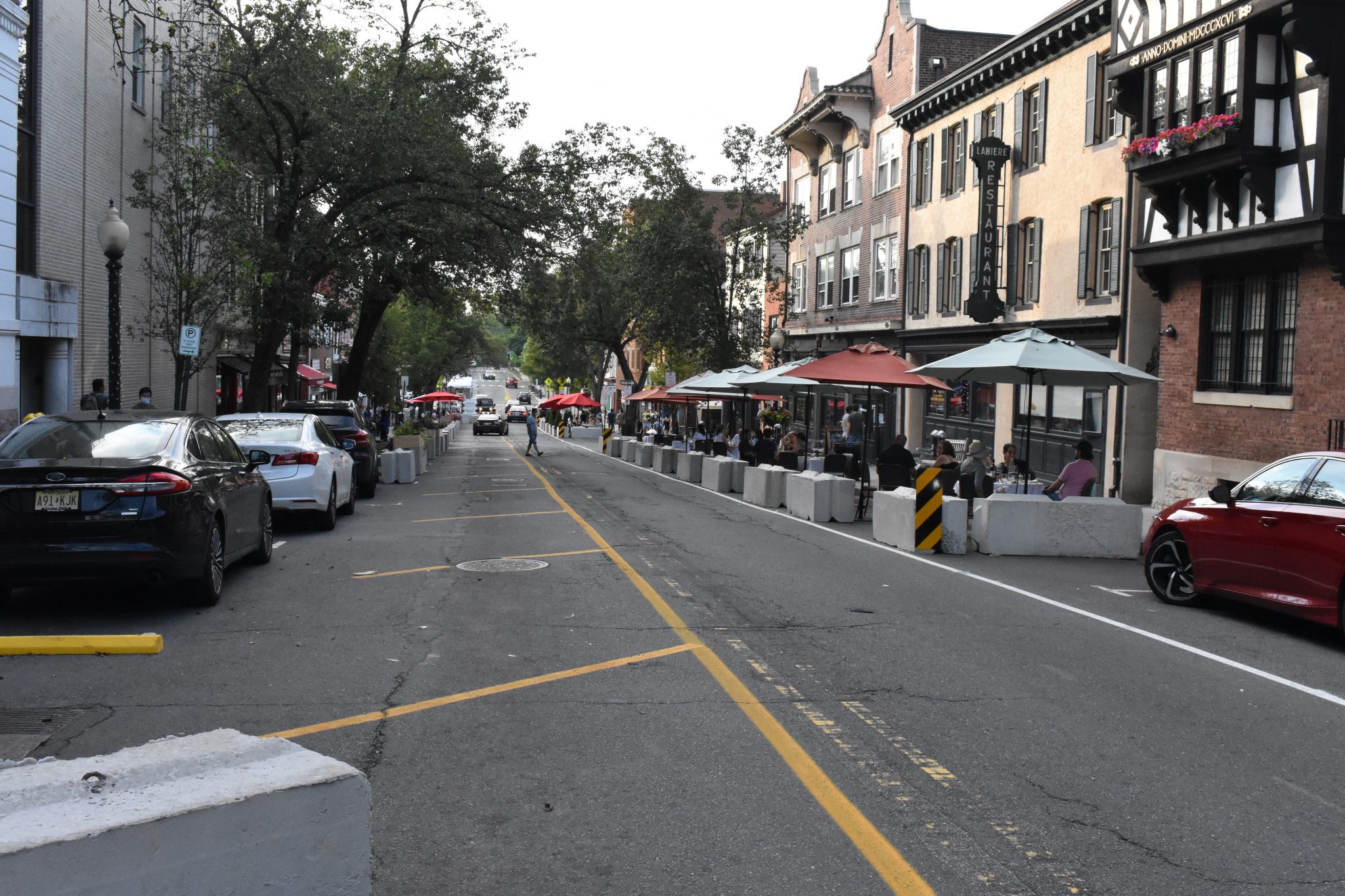Witherspoon Street, which was converted from a two-way street to a one-way street between Nassau Street and Spring Street as an experiment earlier this year, could remain a one-way street.
The Princeton Council introduced an ordinance that keeps the one-way configuration of Witherspoon Street northbound at its Dec. 7 meeting. The vote was unanimous.
A virtual public hearing and final action on the ordinance is set for the Princeton Council’s Dec. 21 meeting.
The ordinance stipulates that Witherspoon Street will continue to be a one-way street northbound, which means cars will travel “down” the hill on Witherspoon Street from Nassau Street.
There will be one lane for cars and trucks. The rest of Witherspoon Street will be redesigned to accommodate pedestrians, bicycle parking, outdoor dining, public art, green infrastructure stormwater management and other non-motor vehicle uses.
While the Princeton Council’s vote to introduce the ordinance was unanimous, reaction from the public was mixed. Residents and a few business owners and their representatives favored the change – especially accommodations for outdoor dining – but at least one business owner expressed some concerns about it.
Although the one-way configuration was implemented in part as a result of the COVID-19 pandemic to help the restaurants on Witherspoon Street, Princeton officials had already been studying potential changes to the street.
Those changes are being sparked by a $610,000 grant from the New Jersey Department of Transportation to pave a portion of Witherspoon Street and to make other improvements – from new curbs and sidewalks to updated street lighting and street trees.
In the meantime, the Princeton Council hired McMahon Associates to conduct a traffic study of Witherspoon Street and to examine four possible designs for it. The options included restoring it to a two-way street; converting it to a one-way street northbound; converting it to a one-way street southbound; and closing it to create a pedestrian mall.
McMahon Associates recommended keeping the one-way northbound configuration, which is the design alternative that was introduced in the ordinance at the Princeton Council’s Dec. 7 meeting.
Although Witherspoon Street is a municipally-owned street, the ordinance states that the change will not take effect until the New Jersey Department of Transportation – which controls Nassau Street/Route 27 – approves the project and issues the appropriate permits.
If the ordinance is approved later this month and the New Jersey Department of Transportation approves the project, changes to the traffic flow on nearby streets may need to be put into place, according to the McMahon Associates traffic study.
The changes suggested by the traffic consultant include flipping S. Tulane Street – between Nassau Street and Spring Street – into a one-way street southbound (toward Spring Street), and banning left turns from Spring Street onto Nassau Street.
The intersections of Wiggins Street and Vandeventer Avenue; Nassau Street and Vandeventer Avenue/Washington Road; and Nassau Street and Chambers Street will likely be impacted by the change to Witherspoon Street, which will shift “a significant amount of traffic” to those intersections, the McMahon Associates traffic study said.
When the meeting was opened for public comment, Michele Moriello, who owns a restaurant on Witherspoon Street and who favors the change, said it represents an opportunity to change and begin something new.
With a more pedestrian-friendly streetscape, people will walk around, shop and eat, Moriello said.
Andrew Siegel, whose family owns Hamilton Jewelers, praised the amount of effort that had been put into it, including the “passionate debate” that is a hallmark of Princeton. Town officials are “pretty well aware” of what the various parties think, and residents and businesses have each made their respective cases, he said.
Implementing the one-way street plan has been “decidedly unsuccessful” for the retail and quick service businesses, Siegel said, but the merchants agreed to it – on a temporary basis – to help the restaurants on Witherspoon Street.
“It worked really well for the restaurants that needed outdoor dining. However, it has not been successful for other businesses. When people say it has been good for business, they meant restaurants and bars. Retail and quick service businesses have been forgotten,” he said.
But despite the differences of opinion, Siegel said, “the truth is, we are all really moving toward the same goal, which is a better Princeton.”
Speaking in favor of a one-way Witherspoon Street, resident Carlos Rodriguez said that what is being proposed is “a step in the right direction.” He said he is a professional planner, and he is currently working on two projects in Somerset County that involve street closures.
Rodriguez said the traffic study commissioned by the town was focused on motor vehicles and not on pedestrians. There was no mention of pedestrians in the traffic study, even though the changes to Witherspoon Street are being done for pedestrians, he said.
“Let’s get our priorities straight. This is a town for people, not motor vehicles. We can tolerate motor vehicles, but these decisions should not be made exclusively with motor vehicles and the convenience for whoever is driving them in mind,” Rodriguez said.

